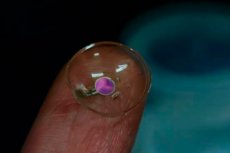New publications
Portable ophthalmodiagnostics: OLED right in the lens
Last reviewed: 18.08.2025

All iLive content is medically reviewed or fact checked to ensure as much factual accuracy as possible.
We have strict sourcing guidelines and only link to reputable media sites, academic research institutions and, whenever possible, medically peer reviewed studies. Note that the numbers in parentheses ([1], [2], etc.) are clickable links to these studies.
If you feel that any of our content is inaccurate, out-of-date, or otherwise questionable, please select it and press Ctrl + Enter.

Korean engineers have embedded an ultra-thin OLED directly into a soft contact lens and taught it to work completely wirelessly. Such a lens shines on the retina like a mini-Ganzfeld and allows electroretinography (ERG) to be performed literally “put on and done”: without a stationary lamp, wires, or a dark room. A demonstration of the technology was published in ACS Nano.
Why is this important?
Classic ERG is a special setup, a darkened room, and not the most pleasant procedure. If the light source “moves” directly to the eye, diagnostics will become simpler, quieter, and more mobile — from the emergency room to a home visit. In addition, the “lens-flashlight” opens the way to other tasks: light therapy, delivery of visual information (AR), and analysis of ocular biosignals.
How the "lens-lantern" works
- The light is produced by an OLED film with a thickness of ~12.5 microns — 6–8 times thinner than a human hair. Unlike “point” hard LEDs, OLED is an area and uniform source, so it does not need high brightness and it heats up less.
- Power and control are wireless: the receiving antenna and chip are integrated into the lens, and the transmitter can be worn, for example, in a sleep mask; communication operates at 433 MHz.
- "Soft" light is sufficient. At a brightness of only ~126 nits, the lens elicited stable ERG responses no worse than commercial sources.
What the tests showed
- Equivalence to diagnostics. In animal models, the OLED lens reliably evokes ERG signals comparable to classical equipment.
- Thermal safety. The surface temperature of the rabbit eye did not exceed 27 °C — the cornea does not overheat. The lens worked stably in a humid environment close to the clinic.
- Full autonomy. Wireless mode with a mask-controller and possible connection with a smartphone is demonstrated "live".
How is this better than the old way?
- No dark room or bulky lamp. The patient only needs to put on the lens - fewer failures due to fatigue and blinking, easier for children and the elderly.
- Uniform "soft" lighting. Area OLED reduces local heating and brightness requirements - less risk of discomfort.
- Portability and field scenarios. Can be used at the bedside, in screening or on-site.
What's next?
The authors talk about the world's first wireless OLED lens as a platform: diagnostics can be supplemented with retinal light stimulation, AR indication or accommodation training for myopia. But clinical trials on humans, long-term safety (wearable for hours/days), sterilization standards and regulatory approval are ahead.
Source: Sim JH et al. Wireless Organic Light-Emitting Diode Contact Lenses for On-Eye Wearable Light Sources and Their Application to Personalized Health Monitoring, ACS Nano (online May 1, 2025)
